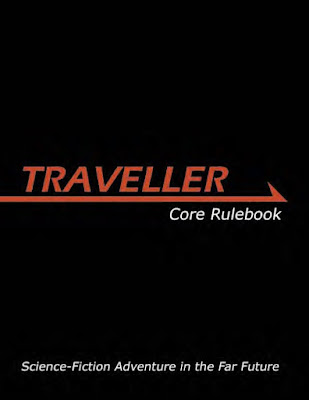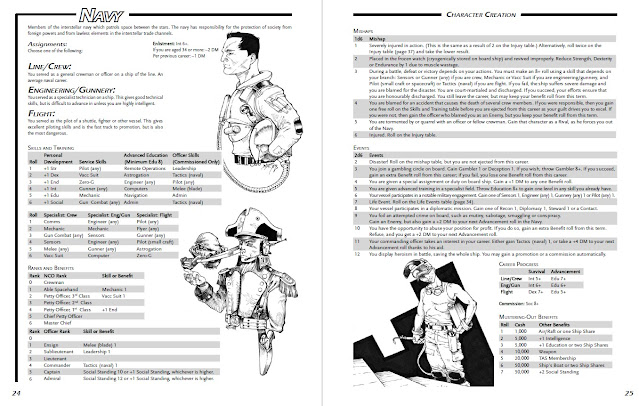2008 was not all that long ago. This blog was up and running at this point and I was beginning work on a lot of the projects you know me well for. So consequently I was not really paying all that much attention to what was going on in the world of Traveller.
While I mentioned that we are hitting the "retro-clone" phase of Traveller's development, it was not (as far as I can tell) Mongoose that released the Traveller SRD. That was the work of Jason Kemp. But I will get to all of that in a bit when I review the Cepheus Engine.
Traveller Main Rulebook (2008)
PDF. 192 pages (plus covers). Black & White art with a red accent.
Traveller has had a long history. This new version from Mongoose celebrates that history by essentially going back to the beginning with the look and feel of Classic Traveller.
How much does this feel like Classic Traveller? So much so that I am kinda struggling with what to say other than "wow this is like Classic Traveller!" Not in a "they copied The Traveller Book" way but more in a "These are people that began playing this game 30 years ago and now want to introduce new gamers to that game" way.
Everything about this book is a serious nostalgia trip. And given that I have been spending all this time with all versions of Traveller, a serious case of déjà vu.
Introduction
Our introduction to the Traveller game. There are some minor references to "The Third Imperium" but much like the LBBs this game is largely setting-free. Some examples of play are given and the various Technology Levels (TL 0 to 15) are given.
Character Creation
This is very, very similar to the Classic Traveller Character Creation even down to our good friend Alexander Jamison returning.
Side note: I have decided that once a character musters out of one of the services (Army, Marines, Merchant Marines, Navy) they are gifted a sword. Seems like something that should happen and explain why Jamison here has a cutlass in a universe full of lasers.
The big changes here (and see throughout this book) are better layout for looking at options and checklists and guides. This version does an amazing job of getting a new player up and going fast.
You can't die in character creation, but there is still a lot going on. Also there is a point-buy feature for assigning your points to your six abilities. We are again back at an average of 7 for abilities and the UPP is back.
There are still a lot of careers to choose from, more than in The Traveller Book. Life events follow. Someone close to your character can die, but not your character. Though you can muster out and be in medical debt.
There is a section on aliens. Here we get the Aslan, Droyne, Hivers, K'kree, Vargr, and the Zhodani. Given the way the rules of this version are written, I can't see why the older Alien Modules couldn't still be used here.
Skills and Tasks
Skills are very familiar but seemed to be pared down a little. Die Modifiers (DM) are discussed as well as how to do a task check right away. Each skill is detailed along with any specialties under that skill.
Combat
This chapter gets an upgrade in my mind and shows the familiarity Mongoose has had with d20 and other modern systems. Actions are divided into Minor and Significant Actions along with Reactions and any number of Free actions. These are made very clear. Combat actions (a significant action) is detailed on what needs to be rolled. All of this was in previous versions, but now they are more upfront and bolded.
Encounters and Dangers
This is the analog to the older Encounters and Animals sections. Plenty of charts and boxed text to help a referee out when building encounters. Encounters are more than just strange new animals on weird worlds. There are rivals, other humans, and corporate actions just to give some examples. Quite a lot really. True to Traveller there are plenty of d66 tables for all these encounters.
Equipment
Your characters' shopping lists. It looks like this is very similar to other equipment lists of other editions. I will note (because this is me) that computers finally feel right. They, and a lot of the other equipment here feel like futuristic equipment. Computers are tiny and powerful. There are "smart guns" that help you hit your target, holographic displays, and robots and drones in their own sub-section.
Each bit of equipment comes with a TL rating.
Spacecraft Design
Distinctions are made between interplanetary and interstellar spacecraft. Like character creation, there is a helpful checklist.
Common Spacecraft. This is less of a chapter section and more of a sub-section of Design. This list of common ships with their details, some maps, and a picture.
Spacecraft Operations
An alphabetical listing of everything (mostly everything) that can go on in a ship.
Space Combat
Similar to other versions and the combat chapter above. This details how ships can fight including movement, targeting, and firing phases. Along with damage and reactions. The chapter is not large but remarkably detailed.
Psionics
Ah. Psionics. Stuck out into the back half of the book again. Psions are given a "career" write-up as the other character types.
Trade
Covers basic trade between the worlds/systems/colonies.
World Creation
This chapter feels more like Classic Traveller than the others. Sadly no equations to apease the math geek in me but a lot of information all the same.
Index
A pretty good index (not hyperlinked), a character sheet, and a hex grid.
--
So this might be the best version of Classic Traveller to date. Same rules more or less (I admit I could not spot any major differences), the feel of Classic Traveller and in a cleaned up and reorganized fashion. I know there is a 2nd Edition coming up (I have already started on that) but there is a simple elegance to this edition.
There is also a Book 0 to get you started. It is a cut down version of the Core Rules at 32 pages and is Free. I have both in the same three ring binder I have The Traveller Book in.



4 comments:
If I didn't have my original LBBs this one might have gotten me to buy, but I do so it didn't. Classic's still my most-played version of the game, with GURPS a distant second.
Well, 2300 is actually probably second if I counted it as being part of Traveller rather than being its own thing, but it is and I don't.
This is the only version I've played (though I have a lot of the other ones). The character creation engine is a fun and engaging mini game as it should be in Traveller and the task resolution system is simple and intuitive and rewards player creativity. I really enjoyed it.
I do rather like this one to be honest. I am looking forward to seeing what 2nd Edition has.
I've never been fond of the way computers are handled in Traveller, and I'm still not, all that much.
Something that should be interesting and more or less central to a sci-fi setting is just kind of a cardboard prop IMO. The programs are dull and they're the only thing that makes such an item useful in the first place. If there's more to them than meets the eye, I feel like Mongoose did a poor job of that, even in the 2nd edition.
Post a Comment